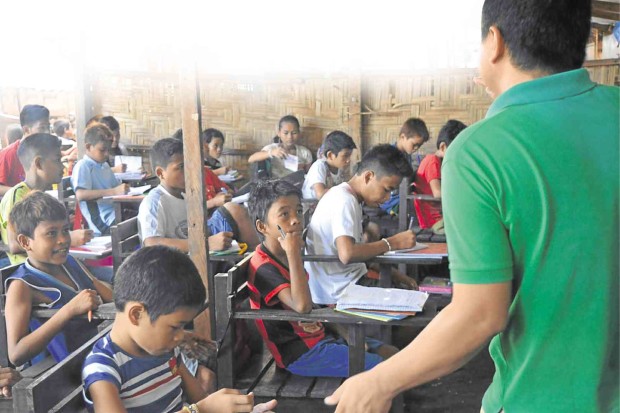School a distant dream for ‘lumad’

CHILDREN of “lumad” evacuees attend class at a makeshift classroom inside a Protestant church compound in Davao City where the indigenous peoples sought shelter for fear of getting caught in the crossfire between communist guerrillas and government soldiers in their communities. GERMELINA LACORTE/INQUIRER MINDANAO
IN A MAKESHIFT classroom with sawali (woven bamboo slats) walls, Manobo children smiled as they listened to a boy read the story of the Monkey and the Turtle.
But noise from passing vehicles and the din of voices of other children in an adjoining room kept drowning the reader’s voice, and the listeners lost track of the narrative.
The children belong to Manobo families who sought shelter at the Haran compound of the United Church of Christ in the Philippines in Davao City.
“We thought we can already go home,” said Ricky Balilid, a volunteer teacher for the Misfi (Mindanao Interfaith Services Foundation Inc.) Learning System for “lumad” in Sitio Muling, Barangay Gupitan in Kapalong town, Davao del Norte.
Balilid, who now teaches the children evacuees in Haran, said he heard that some evacuees who left Haran on June 1 to return home to Talaingod failed to reach home. Those who did were unable to reopen a lumad school in Barangay Palma Gil because soldiers were still there.
“We are still under attack,” said Balilid.
To reach the Misfi school in Sitio Muling, Balilid has to walk for two days and cross the same river 42 times.
In the far-flung village, however, Balilid noticed that children were performing better in class than they did in the shelter.
“Here, children can’t concentrate,” he said. “They score lower in their exams.”
On June 1, some of the evacuees in Haran left for the village of Talaingod in time for the opening of classes. But reports reaching the evacuation site said the teachers failed to reach the school, alarmed by the presence of militiamen in the community.
Salugpongan Ta’Tanu Igkanugon is one of the community learning centers for lumad that the lumad themselves, with the help of private groups, set up to bring education to lumad communities rarely reached by government services.
Accredited by the Department of Education (DepEd), most of the learning centers have won accolades from DepEd for bringing education to indigenous peoples.
But for over a decade, the schools have become constant targets of harassment and vilification campaign by soldiers who link the schools to communist rebels.
Rius Valle, spokesperson of Save Our Schools (SOS) Network Mindanao, said this year alone, SOS had monitored close to 20 lumad schools that failed to open at the start of classes in June, either because of forced evacuation or the presence of soldiers.
Aside from the Salugpongan alternative school for lumad in Barangay Palma Gil in Talaingod town, classes also failed to start in another Salugpongan school in Barangay Anitapan in Mabini, Compostela Valley.
No classes
Classes also did not start in a lumad school in Columbio, Sultan Kudarat, seven schools in Surigao del Sur, 13 schools of the Tribal Filipino Program of Surigao del Sur (TRIFPPS) and two more schools operated by the Alternative Learning Center for Agricultural and Livelihood Development (Alcadev).
Alcadev’s executive director and two lumad teachers were killed by militias last year.
“We are still trying to reach those schools in areas that cannot be reached by telecom signals, trying to verify other reports that reached us,” Valle said.
As of Jan. 27 this year, SOS Network Mindanao monitored nine schools that had been forcibly closed, 18 threatened with closure, 32 where classes were disrupted or suspended because of attacks and three schools that were torched. Between September 2014 and September 2015, the SOS documented a total of 95 cases of attack on 81 lumad schools with at least 4,265 students. Most prominent among these attacks was the killing of Emerito Samarca, Alcadev executive director, and two lumad teachers in Surigao.
In Kitaotao, Bukidnon, a lumad school was closed down and destroyed.
Staying at the Haran compound, considered a sanctuary for lumad at the heart of Davao City, Balilid said he did not feel safe. “We are constantly under surveillance, just like when we were still in the community,” he said.
Lack of peace
Last year, assailants tried to burn the Haran compound.
Alert evacuees helped put out the fire before it could spread. The attackers went to another part of the compound and burned a dormitory where medical students were staying.
Balilid said the lack of peace of mind was having an impact on teachers and the learning process.
“They have threatened to kill us, teachers,” said Balilid. “We’re constantly on alert.”
“Maybe they don’t want the lumad to learn, that’s why they’re always here to harass us,” he added.
He called on President-elect Rodrigo Duterte to listen to the call of lumad.
“Please let the soldiers, and most especially the paramilitary groups, return to the barracks,” Balilid said.
“Please bring us peace in the classroom, and peace in the community so people can plant crops, by letting the soldiers stay out of the community,” he said.
Balilid, who handles Grades 5 and 6, also appealed to Duterte to support education for the lumad.
“I hope that the new President will allocate a budget for the lumad school and even subsidies for teachers,” he said.
When the lumad evacuees first set foot in Haran, children attended classes in rooms with dirt floors. Support groups helped the lumad build makeshift classrooms.
Balilid, however, said the lumad just wanted to go home where their children could go to school.
“Without the soldiers, the place is conducive to learning,” he said. “There, the children can sit properly.”
“I also have a table there,” Balilid said.